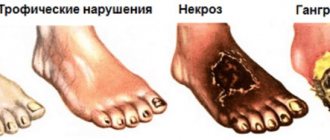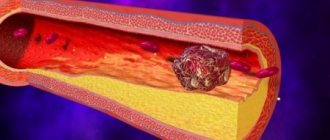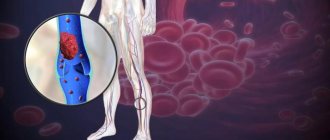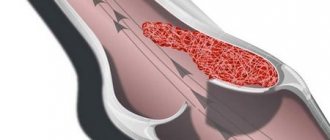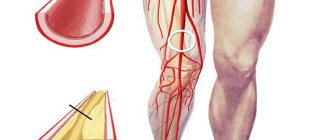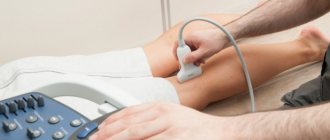Thrombophlebitis is an inflammatory disease of the vessels of the venous system, resulting from the formation of a thrombus (blood clot) in the lumen of a vein.
At the initial stage, when inflammatory changes are mild, the disease is called phlebothrombosis (vein thrombosis without inflammation). It can develop in both deep and superficial veins. More often - in the superficial veins of the extremities. This form of the disease is called superficial thrombophlebitis.
With thrombosis of deep veins located in the thickness of muscle tissue, due to pressure changes, blood clots can break away from the vessel wall and clog small vessels in other parts of the body (brain, lungs, heart). In this case, thrombosis becomes the cause of a serious complication - embolism, which can cause the death of the patient.
Risk factors and causes of development
The pathogenesis of thrombophlebitis of the lower extremities is quite complex. Several factors are simultaneously involved in it:
- increased viscosity and blood clotting;
- slowing down venous blood flow;
- damage to the valve apparatus or vein wall;
- addition of infection.
The most dangerous is thrombophlebitis of the deep veins of the lower extremities. This is due to the characteristics of the blood clot that forms here. A sharp slowdown in blood flow in the affected vein system, combined with increased blood clotting, causes the formation of a red blood clot consisting of red blood cells, a small number of platelets and fibrin strands. One side of the thrombus is attached to the venous wall, while its other end floats freely in the lumen of the vessel. As the pathological process progresses, the thrombus can reach a significant length (20–25 cm). Its head in most cases is fixed near the venous valve, and the tail fills almost the entire branch of the vein. Such a thrombus is called floating, i.e. floating.
In the first few days from the moment the formation of a blood clot begins, its head is poorly fixed to the wall of the vein, so there is a high risk of its separation, which, in turn, can lead to the development of thromboembolism of the pulmonary artery or its large branches.
After 5-6 days from the onset of thrombus formation, an inflammatory process begins in the affected vein, which promotes better adhesion of the blood clot to the venous wall and reduces the risk of thromboembolic (caused by the separation of a blood clot) complications.
In the absence of adequate treatment, in 20% of cases the disease ends in the development of pulmonary embolism, which causes death in 15-20% of patients.
Predisposing factors to the development of thrombophlebitis of the lower extremities are:
- malignant neoplasms (cancer of the pancreas, stomach, lungs);
- disseminated intravascular coagulation syndrome (DIC syndrome);
- postthrombophlebitic disease;
- injuries;
- chronic diseases of the cardiovascular system;
- condition after abortion or other surgical intervention;
- long-term venous catheterization;
- Varicose veins;
- venous stasis caused by prolonged bed rest, pelvic tumors, pregnancy, excess body weight;
- local or systemic bacterial infection;
- postpartum period;
- taking oral contraceptives (in this case, the risk especially increases in women who smoke);
- systemic diseases.
Complications and prognosis
Acute deep vein thrombosis has a different prognosis depending on the type of clot. The occlusive form of the disease is not dangerous, since the thrombus is tightly attached to the wall of the vessel. Parietal thrombosis is also not dangerous. The only risk is its continued growth and transition to a floating thrombus. This form of the disease is life-threatening. Pulmonary embolism occurs as a result of part of the blood clot breaking off and reaching the lungs through the bloodstream. Blockage of the pulmonary artery causes the development of acute failure of the respiratory and cardiovascular systems. If a blood clot blocks a small vessel, a pulmonary infarction develops.
Within several years after the illness, many patients, as a result of damage to the walls of blood vessels and valves, develop postthrombotic syndrome, in which there is a high risk of complications in the form of the formation of new blood clots in the veins of not only the lower but also the upper extremities.
Another long-term consequence of the disease is the development of chronic venous insufficiency due to damage to the valves. The increased load on the superficial veins as a result of the redistribution of blood flow leads to their expansion and accelerated development of insufficiency of these vessels.
Inflammatory diseases, eczema, and dermatitis appear on the skin. Typically, trophic ulcers develop; the skin becomes thin and prone to damage.
Symptoms of thrombophlebitis
Superficial thrombophlebitis develops gradually and begins with slight redness and thickening of the skin in the area of the affected vein.
As inflammation progresses, the area of redness spreads further along the vein. It is usually defined as a thin, dense and painful cord that follows the contours of the vessel. Inflammation can develop in the form of a web, involving smaller veins extending from the affected vessel into the pathological process. Symptoms characterizing thrombophlebitis, even in severe cases, may manifest themselves unexpressedly and be local in nature. In the area of inflammation, the skin becomes tight, hot and painful.
Thrombophlebitis of the lower extremities develops more often, the symptoms of which include the appearance of severe hyperemia and the appearance of a venous pattern in the area of inflammation. Sometimes a blood clot can impair circulation in a limb, causing it to turn blue. The skin over the vein swells, the patient feels constant itching, the pain becomes throbbing and burning. If you quickly change the position of your legs, symptoms may worsen. For example, in the morning when lowering your legs from bed. Patients may also complain of pain when walking. Fever gradually increases. Usually body temperature does not exceed 37.5 - 38 degrees Celsius. For postpartum patients, the development of fever within 4 to 10 days after delivery may indicate the presence of thrombophlebitis.
When an infection occurs, the fever intensifies, severe pain appears, and an abscess can form under the skin, which breaks through with the release of purulent discharge.
Danger of thrombosis
Thrombosis in medicine is a pathological condition in which the composition of the blood changes, its coagulation processes occur, which is accompanied by the formation of blood clots - thrombi. Blood clots prevent normal blood circulation through the venous bed, and if a blood clot forms too large, this can lead to blockage of the vessel and severe circulatory problems that pose a threat to life. For example, the formation of blood clots in the brain area causes a stroke. In most cases, thrombosis forms directly in the lower extremities, where the chance of death is much lower, but the risk of severe damage does not decrease.
If we talk about thrombosis specifically in the deep veins, we are talking about the form of the described pathological process, which affects larger vessels located in the thickness of muscle and soft tissue. This form of the disease is more dangerous, since blocking a large vessel threatens significantly greater damage.
Of course, with the development of thrombosis, a clot can also form in the superficial vein; this disease is called thrombophlebitis, and its danger is much lower. Accordingly, the development of deep vein thrombosis requires more urgent and radical measures to combat the disease.
Vein thrombosis: before and after treatment Advertising partners
Thrombophlebitis of deep veins
Symptoms of deep vein thrombophlebitis include:
- Redness (sometimes blue or pale);
- Local increase in temperature;
- Edema;
- Pain in the affected limb.
Symptoms of thrombophlebitis of the legs with deep vein thrombosis are characterized by more pronounced swelling of the affected limb than with superficial lesions. Upon examination, the difference between the healthy and diseased side is very clearly visible. In addition, patients feel stiffness (tension) of the muscles in the affected limb.
Prevention
You can reduce the risk of complications of thrombosis by the following methods:
- Wearing compression stockings;
- Moderate physical activity;
- Proper nutrition;
- Rejection of bad habits.
A healthy lifestyle and moderate physical activity have a positive effect on blood circulation. This helps restore blood flow during thrombosis and reduces the risk of complications.
Timely treatment of thrombosis is a guarantee of a full, healthy life. Although there is still a risk of a blood clot forming in a vein, the likelihood of developing severe and life-threatening complications is reduced.
What does thrombophlebitis look like (photo)?
Signs of thrombophlebitis of the superficial veins are noticeable even to a non-specialist.
- The skin over the inflamed area of the vein turns red. This occurs due to the expansion of subcutaneous capillaries. Redness (hyperemia) stretches along the leg along the vein. If thrombophlebitis occurred a long time ago, the skin acquires a bluish tint.
- The surrounding veins expand and swell, from which the outflow of blood is impaired.
- A noticeable swelling appears at the site of inflammation. This swelling is the result of the release of the liquid component of the blood through the walls of the capillaries. Liquid accumulates around the cells and permeates the tissue.
Thrombophlebitis of the lower extremities: photo
Diagnostics
Diagnosis of thrombophlebitis includes a visual examination of the patient, identification of complaints, and laboratory tests. The latter do not give a clearly defined picture, so the final diagnosis is made based on the results of instrumental research methods:
- Ultrasound of the saphenous veins can reveal the location and size of blood clots
- rheovasography indicates disturbances in the blood supply to organs and tissues
- Doppler ultrasound allows you to study the characteristics of blood flow
- Ultrasound duplex angioscanning with color coding is the most accurate method to date for studying the condition of blood vessels, which allows you to determine the speed and direction of blood flow in individual areas, examine in detail the condition of the veins, and also identify other important diagnostic indicators
Based on the results obtained, a diagnosis is made and further treatment is prescribed.
Superficial vein thrombosis of the lower extremities: symptoms, treatment
The most common form of the disease is superficial vein thrombosis; as a rule, the vessels of the legs are affected. The reason is that the veins in this area experience the greatest load - this is the most distant part of the riverbed, and the veins have difficulty pumping blood from bottom to top. Varicose changes, if any, are more pronounced on the legs.
Thrombosis of the saphenous veins is much easier to detect than deep veins. When a blood clot forms
- the vein becomes dense and painful to the touch,
- redness of the skin in the affected area is visually observed,
- local temperature rises,
- the limb swells slightly below the location of the blood clot.
Treatment of superficial thrombosis is usually conservative, unless there is a risk of thrombosis spreading to the deep vein system.
- Fixation of a blood clot. If it is possible to diagnose thrombosis in the acute period, there is a danger of fragmentation of the blood clot and removal of pieces of the clot with the blood flow to the heart. Therefore, bed rest is prescribed for a week, complete rest of the affected limb, and local use of anti-inflammatory and absorbable ointments.
- Fighting the inflammatory process. Non-steroidal anti-inflammatory drugs and drugs to normalize metabolic processes are prescribed - troxevasin, aescusan, ascorutin.
- Prevents thrombus formation. Aspirin is used as a disaggregant.
In the future, the motor regime is gradually expanded, carrying out mandatory compression of the saphenous veins using special stockings or elastic bandages. Surgical removal of varicose veins is recommended after 2-3 months. after thrombosis.
Superficial thrombi, which are dangerous in terms of complications, are located in the thigh area in the great saphenous vein and in the popliteal region in the small saphenous vein. These cases are subject to surgical treatment - either the blood clot is removed or the mouth of the saphenous vein is ligated where it flows into the deep vein.
How to treat thrombophlebitis of the lower extremities?
Complex treatment of thrombophlebitis of the lower extremities is carried out using drugs from the following groups:
- Antibiotics from the group of tetracyclines, penicillins or cephalosporins. They are prescribed when thrombophlebitis of the lower extremities is caused by a bacterial infection.
- Sulfonamides. They are used to combat pathogenic microorganisms that are not affected by antibiotics.
- Anticoagulants of indirect action. They are prescribed to prevent blood clots. The dosage of the drugs is selected individually depending on the patient’s sensitivity and blood clotting. They should not be prescribed in the presence of fresh wounds, tuberculosis, kidney disease or during menstruation.
- Proteolytic enzymes. Drugs in this group are combined with anticoagulants. They have thrombolytic and anti-inflammatory effects.
- Antispasmodics. The drugs are used to eliminate vasospasm.
- Corticosteroids. They have an anti-inflammatory effect, reduce swelling and itching. They are not prescribed if the cause of thrombophlebitis is a bacterial infection.
- Non-steroidal anti-inflammatory drugs. Drugs in this group eliminate the inflammatory process and reduce pain.
- Vitamin complexes containing vitamins A, E, C, group B, rutin. They strengthen blood vessels, improve the functioning of the immune and nervous systems.
In case of acute thrombophlebitis, the patient is advised to rest in bed with the legs elevated. In most cases, a patient with this diagnosis needs to limit physical activity for 10–12 days. If the body temperature has returned to normal, the pain and crawling sensation have disappeared, the patient is allowed to get up.
Sometimes symptoms of thrombophlebitis of the lower extremities are observed for several months, which indicates the transition of the disease to a subacute or chronic stage.
For superficial thrombosis, when there is no threat of thrombus detachment, strict bed rest is indicated for 3–5 days.
In the future, the patient is recommended to limit physical activity, running, fast walking or lifting heavy objects, which requires tension in the lower extremities.
Causes of thrombosis and its signs
- If the integrity of the vascular wall is compromised, the development of thrombosis begins. This usually happens as a result of injuries, during pregnancy, when the vessels narrow and become deformed, or if the doctor’s recommendations are not followed after operations.
- When blood stagnation occurs - due to insufficient physical activity or prolonged bed rest. Venous congestion often leads to deep vein thrombosis and varicose veins. To reduce the risk of developing blood clots, it is recommended to use venotonic agents for varicose veins: for example, Normaven® Leg Cream. This product was developed by specialists from the pharmaceutical company VERTEX, has undergone clinical studies and has all the necessary documents and quality certificates confirming its effectiveness and safety. As a result of the testing, it was found that a three-month course of using Normaven® Leg Cream helps to improve the condition of the blood vessels of the lower extremities, due to which cramps disappear, the severity of the venous pattern decreases, swelling and a feeling of heaviness in the legs disappear.
- When the number of platelets and red blood cells in the blood increases, blood clotting parameters change. The cause may be hormonal imbalances, metabolic disorders and oral contraceptives.
- Thrombosis can develop in patients with cancer, as well as with kidney dysfunction.
Factors that increase the risk of thrombosis:
- injuries;
- obesity and excess weight;
Obesity and excess weight are factors in the development of thrombosis
- pregnancy and childbirth;
- smoking;
- infections;
- long-term and frequent trips and air flights;
- age from 40 years;
- taking medications that increase blood clotting;
- surgical intervention on joints and abdominal operations under anesthesia;
- bone fracture;
- sedentary lifestyle.
Surgery
In the absence of positive dynamics in the course of therapy with further progression of thrombophlebitis and inflammation of the veins, surgical methods are used. Surgical intervention must be carried out in rather complex situations of the development of the disease, since increased thrombus formation can lead to embolism and death.
As a retrospective analysis shows, 25% of all cases of thrombophlebitis of the deep vessels of the lower extremities lead to thromboembolism with inadequate therapy.
Phlebothrombosis of the superficial veins, which develops in the groin area, is quite complex and dangerous, since this is the place where the deep and superficial veins of the lower extremities of a person merge. Formed blood clots in the upper veins can enter larger deeper ones. It is in the deep veins that in most cases the blood clot detaches from the vessel wall. The main method of treatment in this case is ligation of the affected vessels, which avoids further development of the disease. After surgery, vein ligation is performed. The operation is performed under local anesthesia. After the operation, the patient can be immediately discharged and return to a full life, without any restrictions on activity.
Modern technical equipment in medical institutions makes it possible to very accurately determine the location where a blood clot develops. This allows for gentle surgical intervention without removing the affected vessel. After stabilization of the condition, additional removal of varicose nodes can be performed, since they can cause re-development of the disease.
Non-traditional treatment methods
Treatment of the disease with home recipes, in consultation with the doctor, is carried out after the acute inflammatory process has subsided. The following folk methods will help prevent recurrent thrombophlebitis of the superficial veins of the lower extremities:
- Honey compress. Apply at night. Using a medical spatula or your hand, honey is applied to the skin of the affected leg in a thin, even layer. Then the compress is wrapped in a thick cloth, preferably linen.
- Cabbage leaf. A lightly beaten white cabbage leaf, washed under water, is applied to the affected area, previously lubricated with vegetable oil. Then the leg is wrapped in cloth and wrapped in an elastic bandage.
- Apple cider vinegar rub. Fifteen milliliters of vinegar are diluted in a glass of water, and the resulting rub is rubbed into the skin two to three times a day.
To relieve inflammation during thrombophlebitis, apply fresh cabbage leaves to the affected areas at night.
Home remedies based on fruits, vegetables and herbs have a more effective effect on thrombophlebitis of the deep veins of the lower extremities:
- Nettle infusion, used internally, has a positive effect provided that you follow a diet that includes avoiding animal protein.
- A mixture of onions, lard, millet, with the addition of soap shavings. Grind the ingredients until mushy. Apply to the affected area.
- A product based on apple wine with the addition of calamus powder. Take fifteen milliliters orally three times before meals.
Prevention of thrombophlebitis of the lower extremities, aimed at preventing the primary disease or the occurrence of relapses, includes the following measures:
- adherence to a diet consisting of maximum consumption of berries, fruits, vegetables, cereals, and a minimum of animal fats, meat, and canned foods;
- quitting smoking and alcohol abuse;
- water procedures;
- walking, moderate physical activity;
- use of compression hosiery.
Carrying out basic preventive measures, following recommended nutritional principles, and monitoring your well-being are factors that ensure the prevention of the development of thrombophlebitis.
Detralex for thrombophlebitis: does it help or not?
In some cases, for the treatment of varicose veins, a phlebologist may decide to prescribe the drug Detralex.
But there is a limitation: it can be used by expectant mothers only in the second half of pregnancy. This is an effective drug for the treatment of varicose veins of any stage and other diseases of the circulatory system, which is considered completely safe. It contains components of plant origin. It does not change the composition of the blood, but only increases the tone of the walls of blood vessels. It has no side effects, but there is a possibility of an allergic reaction.
But in the treatment of thrombophlebitis it gives positive results in combination with disaggregants and thrombolytic drugs. It is rarely used as an independent treatment for thrombosis, mainly to relieve attacks of chronic venous insufficiency. But it is often prescribed after surgical treatment of thrombophlebitis, as a maintenance, long-term therapy.
Treatment of pathology
Thrombophlebitis of superficial and deep veins leads to serious consequences. Some of them cannot be cured. The only way to prevent them is to carry out timely therapy for vascular thrombosis.
On a note!
It is easier to cope with thrombophlebitis if concomitant pathologies, varicose veins or impaired blood flow are simultaneously treated.
Blood flow during thrombosis can be restored using conservative and surgical treatment. The treatment method depends on the patient’s condition and what complications he has already encountered.
Conservative treatment of thrombophlebitis with drugs lasts for at least six months. The patient takes phlebotonics, anticoagulants, and nonsteroidal anti-inflammatory drugs. If there is a high risk of a blood clot forming in a vein, strict bed rest is prescribed.
On a note!
Sometimes local injections with blood thinning drugs are used. This therapy refers to emergency measures in case of blood clot formation.
Surgical treatment is carried out using several methods:
- At the initial stage, a special catheter is inserted into the vein cavity, which removes the clot;
- A vena cava filter may be installed to prevent the blood clot from moving to the internal organs;
- The vein is sutured, due to which passages are formed inside the blood clot through which the blood supply is restored;
- A thrombectomy is performed, in which the formed clot is removed from the vein cavity.
The patient must understand that the sooner he seeks medical help, the fewer complications there will be due to the formation of a blood clot in a vein. Clots that are more than 7 days old cannot be removed using a minimally invasive method.
Treatment of thrombosis with various methods
Exercises
If you have a “standing” or “sedentary” job or suffer from varicose veins, then be sure to perform several exercises daily to prevent thrombophlebitis.
- Unloading of veins. Place your feet on the pillow so that they are elevated at a 20-degree angle. Stroke them from the feet to the thighs. This exercise is suitable even for pregnant women and patients who are forced to remain in bed.
- Bike. Lying on your back, pedal imaginary bicycles.
- Rotation of the feet. Lying on your back, lift your legs vertically up. Rotate your feet alternately or simultaneously.
- Scissors. Lying on your back or sitting on a chair, raise your legs. Alternately cross and breed them.
- Move your fingers. Straighten your legs while sitting or lying down. Bend and straighten your toes.
- Calf raise. Stand straight, feet together, palms pressed to your thighs. While inhaling, rise onto your toes, and while exhaling, lower to the starting position.
Perform each exercise 3-5 times in the morning and evening.
Massage
Massage for thrombophlebitis of the lower extremities. In the acute stage of thrombophlebitis or phlebothrombosis, massage is contraindicated due to the risk of developing pulmonary embolism. Massage is useful during the rehabilitation stage and as a prevention of thrombosis. It affects blood capillaries, improves overall lymph and blood flow. The main massage techniques for venous insufficiency are stroking and rubbing the limb.
Stroking should be performed along the vein, starting from bottom to top. It helps increase blood flow, has a training effect on blood vessels, and reduces swelling. An auxiliary element of stroking - rubbing - is also used along the flow of lymph. Techniques are performed with both hands, clasping the limb on both sides in the shin area, gradually moving to the groin area.
Treatment of deep vein thrombosis in Moscow
At this stage, many government institutions in Moscow are involved in the treatment of deep vein thrombosis of the lower extremities, but only in the Yusupov Hospital will patients be able to undergo full comprehensive diagnostics and outpatient clinical treatment. The clinic employs phlebologists specializing in deep vein thrombosis, engaged in scientific research and developing new approaches to the treatment of this disease. Thanks to international cooperation with large European and American centers, the hospital has the opportunity to use the most effective and high-quality drugs for the treatment and prevention of thrombosis.
The doors of the Yusupov Hospital are open around the clock. No one is turned away here and they help the most difficult patients. The clinic invites everyone to undergo a phlebological check-up and receive advice from doctors of the highest category. The cost of a comprehensive program includes a full package of services: daily examinations, round-the-clock consultation, drug and surgical treatment, in some cases, even rehabilitation measures. The hospital guarantees all patients examination not only by one specialist, but also by a whole galaxy of competent experts: therapist, cardiologist, surgeon, endocrinologist, nutritionist, neurologist, etc. For the purpose of psychological support, a psychotherapist provides consultations at the clinic. Treatment of deep vein thrombosis of the lower extremities at the Yusupov Hospital costs from 40,000-60,000 rubles.
Nursing and junior medical staff are the pride of the Yusupov Hospital. Highly qualified nurses will always come to the rescue, at any time of the day. Having an incalculable amount of work experience behind them, they know all the nuances of the course of a particular disease down to the smallest detail. Comfortable surroundings and a cozy atmosphere will make your stay in the hospital a joyful and quick one.
Treatment of patients at the Yusupov Hospital is carried out only with the help of innovative techniques used throughout the world.
Author
Olga Vladimirovna Boyko
Neurologist, MD
Nutrition and dietary recommendations
Nutrition for thrombophlebitis does not impose strict prohibitions. But you will have to follow some rules.
| It is recommended to add to the diet: | It is recommended to limit the consumption of foods: |
|
|
Traditional treatment
Is it possible to treat thrombophlebitis with traditional medicine? Today doctors say that it is possible, but only as part of complex therapy. Thrombophlebitis symptoms and treatment should be monitored by a doctor.
The following methods are considered the most effective methods of alternative treatment:
- Oak bark. You need to make a decoction of 1 tablespoon of dry bark and a glass of boiling water. The mixture should be simmered over low heat for 25-30 minutes. Take 1 tablespoon before meals for 14 days. Oak bark relieves inflammation and strengthens the walls of blood vessels.
- A decoction of hop cones. You will need 2 tablespoons of buds. They need to be filled with 2 cups of boiling water and heated in a water bath for 20 minutes. The broth should cool at room temperature. Take half a dose before meals for 20 days. Hop cones have anti-inflammatory, analgesic and strengthening effects.
- Honey with garlic. You will need 300 gr. liquid honey and 250 gr. chopped garlic. The ingredients must be mixed and left at room temperature for 7 days. Take 20 g. before meals for 40 days. This medicine has anti-inflammatory and vascular strengthening properties.
General recommendations and prevention
People who are at risk for thrombophlebitis need to be very attentive to the condition of their hands and feet. Follow the recommendations given by the phlebologist. You should lead an active lifestyle. Try to walk more, master special exercises that prevent the development of the disease. It's good to go swimming and ride a bike. At home, you can maintain the tone of blood vessels with vitamin teas, drink cranberry juice and St. John's wort tincture more often.
At the same time, avoid static tension, which occurs when a person sits or stands for a long time (for example, working at a machine). Steam baths and dehydration are contraindicated for thrombophlebitis. Shoes should be as comfortable as possible, with optimal heel height and orthopedic insoles. It is recommended to rest while lying down, slightly raising your legs and placing a small pillow under them. Compression garments should also be worn while lying down, with your legs raised up.
Treatment prognosis
The prognosis for thrombophlebitis of the lower extremities is serious. In the absence of adequate treatment, in 20% of cases the disease ends in the development of pulmonary embolism, which causes death in 15-20% of patients. At the same time, timely administration of anticoagulant therapy can reduce mortality by more than 10 times.
Cherries and raspberries are useful for thrombophlebitis of the lower extremities. They contain a natural anti-inflammatory substance - salicylic acid, which reduces the activity of the inflammatory process and has some anticoagulant effect.
Atherosclerosis of the vessels of the lower extremities Varicocele Diabetic foot - treatment with drugs and foot care at home Sepsis Hemorrhoids Heel spur: symptoms and treatment
Drug treatments for thrombophlebitis
In case of superficial inflammation, without the inclusion of deep vessels in the pathological process, which is confirmed by diagnosis and symptoms, treatment is prescribed conservatively, carried out at home. Drug treatment combines taking medications, local treatment, and wearing compression stockings. Drug therapy for thrombophlebitis involves the use of the following groups of drugs:
- anti-inflammatory (“Diclofenac”);
- agents that strengthen the vascular wall (“Troxevasin”);
The goal of treatment is to reduce pain/inflammation and prevent complications from developing
- blood thinners (“Aspirin”);
- topical preparations that dissolve blood clots (“Lioton”);
- anticoagulants – with a high risk of complications;
- fibrinolytic drugs (“Chymotrypsin”);
- antibiotics – if the temperature rises, there is a risk of developing a purulent process.
The use of medicinal leeches has a positive effect in the treatment of thrombosis of the lower extremities. Hirudotherapy is indicated for patients who are intolerant to anticoagulants. Hirudin - iron in leeches, helps reduce viscosity, slows down clotting. Contraindications for use: pregnancy, taking mercury-based medications.
Physiotherapeutic methods used for thrombosis include:
- ultraviolet irradiation;
- infrared irradiation;
- ultra-high frequency therapy;
- electrophoresis;
- high-frequency magnetic therapy;
- Sollux;
- paraffin applications.
In the treatment of ascending thrombophlebitis, laser obliteration is also used, the essence of which is to heat the vein wall just above the thrombus
The methods allow you to relieve inflammation and pain. Restore hemodynamics, reduce blood clotting. Conservative treatment of thrombophlebitis of the deep veins of the lower extremities ends with gradual activation by performing simple exercises included in the complex of physical therapy. Classes are conducted under the guidance of a methodologist.
